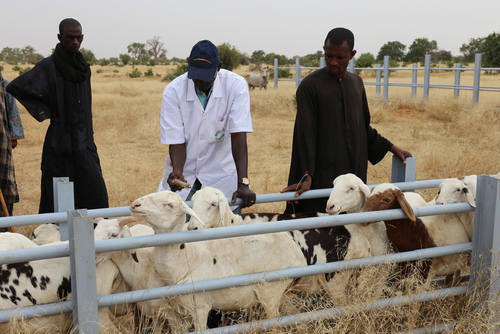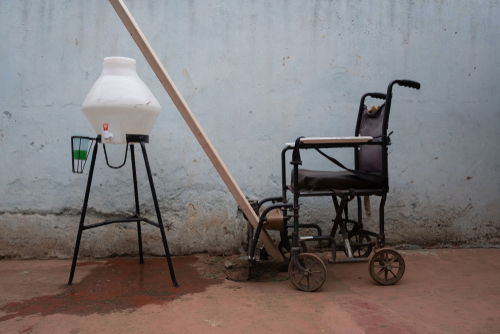April 17, 2024

Highly Pathogenic Avian Influenza A (H5N1) detected in penguins and marine birds in Antarctica
Last month, researchers confirmed the presence of H5N1 clade 2.3.4.4b, or highly pathogenic avian influenza, in penguins and cormorant birds in Antarctica. While reports in remote Antarctica are scattered and suggest fewer bird deaths than expected, scientists are concerned about the potential spread of the virus to new regions; at present, H5N1 is detected in all continents except Australia. Scientists are currently using genetic sequencing and remote sensing to map the spread of infection to prevent further transmission of the deadly virus in Antarctica. [Science]
Tracking antibiotic resistance genes along the pig farm-to-slaughterhouse pipeline
A longitudinal study of a swine farm in Italy identified a diverse set of antibiotic resistance genes (ARGs) dispersed at high rates between pig gut microbiomes and the internal and external farm environments. Through metagenomic sequencing, researchers found that 309 out of 530 species-level genome bins were shared across ecosystems at varying points in the farm-to-slaughterhouse pipeline. The majority of pervasive pig microbiome components were found in wastewater, implicating wastewater as an important reservoir for ARGs and bacteria in food systems. [Animal Microbiome]
Phylogenetic analysis of avian influenza virus subgroups in South Korea
A national surveillance and genotyping program during South Korea’s 2020-2021 highly pathogenic avian influenza (HPAI) season revealed the emergence of novel HPAI genotypes among diverse wild bird populations. A phylogenetic analysis of virus isolates collected from wild birds highlighted the introduction of two genetically distinct H5N8 clade 2.3.4.4 virus subgroups during the 2020-2021 winter season. The genotypic complexity of these distinct subgroups points to the rapid, ongoing evolution of the H5N8 HPAI virus in the dense wintering habitats. [One Health]
Assessing the efficacy of typhoid vaccines in typhoid-endemic settings
According to a systematic review of 14 randomized controlled trials, typhoid vaccines have high efficacy against culture-confirmed Salmonella enterica serovar Typhi. The Vi polysaccharide conjugated to recombinant Pseudomonas aeruginosa exotoxin A vaccine (Vi-rEPA) had 89 percent efficacy, but this vaccine was only investigated in 1 study. Notably, the vaccine efficacy of the Vi-tetanus toxoid conjugate vaccine (TCV) was significantly higher among individuals aged 5 years and above (87 percent) compared to children under 5 (73 percent). The pooled efficacy was 45 percent for the Ty21a live-attenuated oral vaccine and 58 percent for the Vi capsular polysaccharide vaccine. [The Lancet Global Health]
Child wasting associated with malaria treatment failure and reinfection
A meta-analysis of individual patient data from the WorldWide Antimalarial Resistance Network revealed that children under-five with acute malnutrition and uncomplicated Plasmodium falciparum malaria were at a greater risk for delayed parasite clearance, artemisinin-based combination therapy (ACT) failure, and reinfections. Decreases in weight-for-height Z-score (a measure of wasting) were associated with increased risk of day 2 positivity (adjusted odds ratio: 1.12); treatment failure (adjusted hazard ratio: 1.14); and reinfection after therapy (aHR: 1.09). [The Lancet Global Health]
Identifying and mitigating ‘healthwashing’ in climate negotiations
Health was highlighted as a key focus of current and future climate actions at the 28th UN Climate Change Conference (COP28). However, public health practitioners have called out the act of “healthwashing,” wherein health terms and identifiers are exploited to advance self-interests that inherently contribute to poor health outcomes. This phenomenon was apparent in COP28 negotiations in which countries embraced climate and health declarations while actively promoting polluting practices for economic gain. The global public health community has a responsibility to identify and dismantle healthwashing in climate declarations, and state and non-state actors must use specific, time-bound, and clear language in their commitments to climate action. [PLOS Global Public Health]
Carriage of resistant Enterobacterales species in pregnant women and neonates in Ethiopia
In a prospective cohort study in North Shewa Zone, Amhara, Ethiopia, carriage of extended-spectrum beta-lactamase (ESBL-) producing organisms was common (22.3 percent in pregnant women; 24.5 percent in their neonates), while carriage of carbapenem-resistant Enterobacterales was rare. Neonates whose mothers tested positive for ESBL-producing organisms were at a greater risk of testing positive for ESBL-producing organisms than neonates with mothers who tested negative (38.7 percent versus 21.1 percent). [International Journal of Infectious Diseases]
Factors associated with drug-resistant tuberculosis and related mortality
A retrospective, cross-sectional study of drug-resistant tuberculosis (DR-TB) patients at the Kabwe Central Hospital in Zambia revealed that nearly half of DR-TB patients (49.2 percent) comprised relapse cases. Risk factors for DR-TB mortality included male gender (adjusted odds ratio: 0.26) and age between 36 and 45 years (aOR: 0.253). Based on the high prevalence of drug resistance among TB patients identified in this study (1.4 percent), recommended next steps include public awareness campaigns and directly observed therapy (therapy administered by healthcare workers or trained personnel) for new and relapsing TB patients. [BMC Infectious Diseases]
Transmission routes of avian influenza virus in animal models
An animal model study demonstrated high pathogenicity, mortality, and transmissibility of a novel isolate of the highly pathogenic avian influenza A (H5N1) virus (clade 2.3.4.4b), isolated from a severe human case of avian influenza in Chile. The findings of this study indicate that direct contact between co-housed ferrets, rather than inhalation or contact with contaminated surfaces, led to infection. Although the virus does not display an airborne transmissible phenotype in mammals, constant monitoring of virus evolution and adaptation in mammals is warranted to prepare for future pandemics. [Emerging Microbes & Infections]
Community antibiotic use in men with urethral discharge syndrome in Uganda
A cross-sectional study of men seeking care for urethral discharge syndrome (UDS) in Kampala, Uganda, found that 40 percent of participants used antibiotics to treat their UDS before their first clinic visit. A previous history of UDS treatment in the last six months and symptom duration for less than six days were positively associated with pre-enrollment antibiotic use. The prevalence of gonorrhea (66.4 percent) and Mycoplasma genitalium (12.0 percent) among the study population and high community usage of antibiotics raises concerns about antimicrobial resistance selection pressures in pathogens that cause sexually transmitted infections. [PLOS One]
Image from Shutterstock











